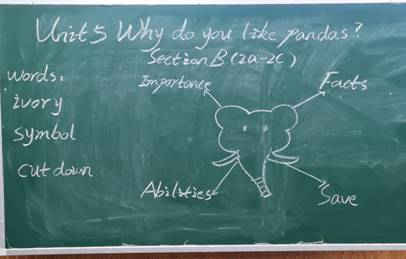教材分析 |
This unit is mainly about animals and students in the seventh grade are very interested in it. The language objectives are to guide students to use the adjectives to describe animals and express preferences. This lesson is the second period of the unit, and it is a reading lesson. The topic is about elephants, so teachers and students will carry out a series of class activities based on the topic on how to save the elephants in danger. It is closely related to students’ daily life and can improve students’ communicative ability and cultural awareness of protecting animals. |
学情分析 |
Students have learned animal words and some adjectives to describe animals in the first listening and speaking lesson of this unit. They can clearly express their ideas and finish the reading tasks. By studying in pairs and groups, students can use the target languge in a realistic setting and get to know how to love and save animals. |
教学目标 |
1.Knowledge objectives Students can master the following words and expressions: “save, symbol, forget, get lost, danger, be in great danger, cut down, ivory, Thailand” 2.Ability objectives a. Students can accurately obtain relevant information about elephants from the reading material. b. Students can master reading strategies to promote thinking and improve reading ability. 3.Emotional objectives Students will get to know how to save animals and love animals. |
教学重难点 |
Key points: 1. The students can understand the main idea of a short passage by finding out the topic sentence of each paragraph. 2. The students can construct the mind map of the reading material by careful reading. Difficult points: 1. The students are able to retell the passage by the mind map. 2. The students’ awareness of protecting animals will be cultivated and they know how to protect animals. |
教学方法 |
Task-based Language Teaching Method |
教学手段 |
PPT, pictures, blackboard, chalk |
教学过程 |
教学环节 |
教师行为 |
学生行为 |
设计说明 |
Step1: Lead-in |
1. Greeting to the students. 2. Playing a video about animals and then ask students questions: What animals can you see? 3. Draw an elephant on the blackboard. |
1. Greeting to the teacher. 2. Talk about their ideas about the questions. |
1. Greetings from teachers and students, group presentation, create an atmosphere, stimulate enthusiasm, activate old knowledge. 2. After watching the animal video, teachers and students have a simple dialogue on the animals, which is a natural continuation of the link and also a review of the content of the last lesson. 3.Draw an elephant to start the blackboard design. |
Step2:Pre-reading |
1. Talk about features of the elephants. 2. To guide students to get the meaning of the words by pictures and the contexts. |
1. Learning the new words by pictures and the contexts. 2. Get some information about the elephants. |
This session mainly focuses on learning new words and eliminating reading barriers
|
Step3:whlie-reading(Fast-reading) |
1.Show the tips of reading skills. 2.Ask students to answer the questions.
|
1.Read fast and underline the topic sentence of each paragraph. 2.Answer the questions.
|
According to speed reading, students learn to capture key information and grasp the reading material as a whole |
Step4:while-reading(careful-reading) |
Guide students to read the passage carefully and answer the questions. e.g. Why are elephants important in Thailand? |
Read fast and underline the topic sentence of each paragraph and answer the questions.
|
Ask the students to read the passage carefully and get more information by looking for details |
Step4:After-reading |
1.Let the Ss work in group of four to draw the mind map and ask one of them to retell the passage. 2.Play a video about the killing of the animals and awaken students to protect the animals.
|
1.Draw the mind map and tell the story using their own words with the help of the mind map. 2. Watch the video and discuss how to save the animals in groups. |
1.Retelling the text can help students deepen their overall understanding of the text and consolidate their English knowledge through repeated reading of the reading material. 2.Watch the video through students' perception articles and guide students to love and protect animals spontaneously |
.Step5:Summary |
To encourage the students to sum up the knowledge learnt in this class. |
Try to speak out the words and phrases about the text. |
Deepen knowledge understanding, systematically review the knowledge of this lesson, paving the way for homework arrangement |
Homework |
1. Follow the tape to read the passage and sent the recording to the teacher. 2.Retell the passage with the mind map and write it down on the exercise book.
|
|
Homework is graded according to the student's level. |
设计理念与思路 |
New curriculum standard level 3 learning strategy standard requirements: to learn the content of the initiative review and induction exercise students' communicative ability and ability |
教学反思 |
Students may still lack vocabulary foundation in communication, but students can better understand elephant culture and learn to love animals. Teaching links should be more compact and relevant knowledge should be expanded |
板书设计:
|

|